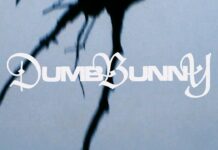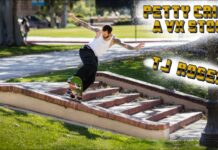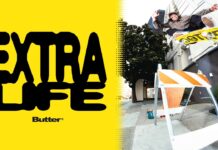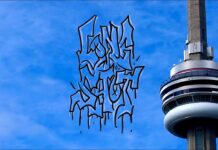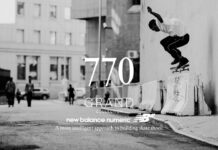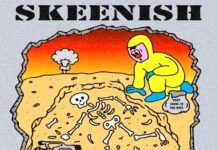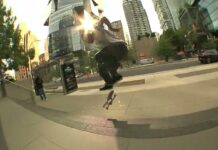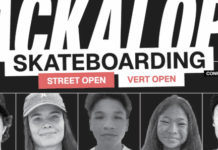There are a thousand ways to complain about a skatepark. Maybe the transitions are too mellow and the coping is too small. Maybe it lacks the specific features that make you excited to skate, whether that is a ledge, manual pad or pool. Perhaps the layout just lacks flow, and you find yourself stifling your momentum and cutting your line much shorter than it needs to be. Or maybe the scooter kids are so numerous and so relentless that you can’t even roll from Point A to Point B. Whatever the reason, we always seem to find something to talk shit about. In fact, as skaters, shit talking seems to be one of our most well-honed skills, right up there with guzzling cheap brews and avoiding conventional adult responsibilities. So when a new park pops up that is almost unanimously celebrated by a notoriously discerning community, we have to ask: “What the hell went right?”

Located in Queens Park, the newly opened New Westminster skatepark was built to replace the old, torn-out New West park, immortalized in Alex Chalmers’ Sorry video part, among other mediums. From two-foot noping-topped quarterpipes to curved and snaking Derby curbs, an eight-foot pool-block topped deep end, miniature four and six foot kidney pool and much more, the new park offers a breath of fresh air to those of us who feel like Canadian skateparks have been stuck in the past when it comes to bowl and ramp features. The facility contains something for all skill levels while giving a humble nod to the legendary parks of the American Pacific Northwest, serving up a taste of that fabled Oregon ‘crete without the nerve-rattling gnar found in places like Klamath Falls, Newberg and Lincoln City.

“We wanted to create something that was custom.” Says Colin Dion, founder and president of Transition Construction, the company responsible for building and designing the park. “We’re trying to build nothing the same, to build features that haven’t been built before.” The Maple Ridge native has a deep history in skatepark construction, having co-founded New Line Skateparks with his brother Kyle back in 2000 before splitting off to pursue his own vision in 2014. And while Transition has been responsible for building numerous parks since then, New West is only the third park that the company has overseen entirely from its inception, including the design stages.

Much of the design of the New West park can be attributed to Jamie Maley, who describes his process as “drawing on napkins.” While Maley lacks any formal design training, he cut his teeth conceptualizing and implementing the most recent upgrades at Vancouver’s Leeside DIY, transferring the skills he acquired among the dirt and grime of the tunnel to his current role at Transition. When Maley comes up with a layout or an obstacle, he draws it and sends it to Transition’s engineer Jay McIntyre, who turns it into a legitimate digital design that can be applied to a physical project. “Jay has been designing skateparks as long as I’ve been building them.” Colin Dion says. “And when Jamie gave him New West, he was like ‘What the fuck! This is the most challenging park I’ve ever had to draw.’”

And the challenges didn’t stop there. After redesigning the park a modest four times, and moving the location due, in large part, to a nearby theatre group concerned about errant reefer smoke and bad language, the actual building process proved to be anything but a cakewalk. “Typically we pour a park that size in a week.” Says Dion. “This one took us three. I was walking around thinking ‘I don’t know how we’re gonna do that… that’s fucked up.’” But with a talented crew of builders including project manager Danny Wartman, east coast concrete expert Brent Remley, Stevie Davison, Travis Godin, Trevor Moncaster, Stinky Mark, Theo Papanikolaou and others, the park was sculpted into its current immaculate form. “Everyone brought something to the table.” Maley says. “It felt like the ultimate DIY.” With each individual allotted the freedom to add their personal touch, the project was allowed to flourish beyond the sum of its parts.

Ultimately, the park’s congruent functionality and unconventionality can be attributed to an unbridled passion for both building and skating exhibited among the Transition crew. Whether blasting shotcrete or crunching a back smith, applying that last stroke of the trowel or setting up for a nollie flip, you can bet that each crew member is operating straight from the heart. “We get to build these sanctuaries that touch so many people.” Maley says. “And they’re there for so fucking long… forever, basically. Aliens are gonna scope ‘em and be like ‘What the fuck are these things?’” Extraterrestrial visitation aside, New West was built with the long term in mind, intended to keep skaters challenged and engaged for many years to come.

And while New West may not be the dream park for every niche and subgenre within skateboarding (it certainly caters to transition-oriented skaters), there is nothing wrong with a little variety. In the greater Vancouver area, you hardly need to drive for 10 minutes in any direction to get to a skatepark, and the fact is that most of these parks offer a similar experience. Having a park that at least compares to the hallowed ground broken by Dreamland, Grindline and others not only legitimizes our scene on an international scale, but it diversifies and enriches our own subcultural mosaic. “We want to offer a different route for the future of Canadian skateboarding.” Dion says. “Not necessarily the right route. Just different.”

It is always easiest to focus on our differences, and to point out the negative. Maybe that’s why we do it so much. But within our countercultural microcosm, the things that we perceive as setting us apart must seem inconsequential and frankly imperceptible to ninety nine percent of the general population. We’re all just rolling around on little wooden planks with four wheels, and its spaces like New West that can remind us we’re all in this together.

Filmed by Chris Johnson and Sara Siraj
Text by Stepan Soroka
Photos by Rich Odam


